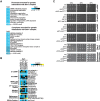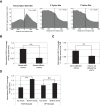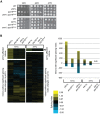The histone variant H2A.Z promotes splicing of weak introns
- PMID: 28446597
- PMCID: PMC5411709
- DOI: 10.1101/gad.295287.116
The histone variant H2A.Z promotes splicing of weak introns
Abstract
Multiple lines of evidence implicate chromatin in the regulation of premessenger RNA (pre-mRNA) splicing. However, the influence of chromatin factors on cotranscriptional splice site usage remains unclear. Here we investigated the function of the highly conserved histone variant H2A.Z in pre-mRNA splicing using the intron-rich model yeast Schizosaccharomyces pombe Using epistatic miniarray profiles (EMAPs) to survey the genetic interaction landscape of the Swr1 nucleosome remodeling complex, which deposits H2A.Z, we uncovered evidence for functional interactions with components of the spliceosome. In support of these genetic connections, splicing-specific microarrays show that H2A.Z and the Swr1 ATPase are required during temperature stress for the efficient splicing of a subset of introns. Notably, affected introns are enriched for H2A.Z occupancy and more likely to contain nonconsensus splice sites. To test the significance of the latter correlation, we mutated the splice sites in an affected intron to consensus and found that this suppressed the requirement for H2A.Z in splicing of that intron. These data suggest that H2A.Z occupancy promotes cotranscriptional splicing of suboptimal introns that may otherwise be discarded via proofreading ATPases. Consistent with this model, we show that overexpression of splicing ATPase Prp16 suppresses both the growth and splicing defects seen in the absence of H2A.Z.
Keywords: H2A.Z; Prp16; Swr1 complex; chromatin; fission yeast; pre-mRNA splicing.
© 2017 Nissen et al.; Published by Cold Spring Harbor Laboratory Press.
Figures







Similar articles
-
The histone variant H2A.Z promotes efficient cotranscriptional splicing in S. cerevisiae.Genes Dev. 2017 Apr 1;31(7):702-717. doi: 10.1101/gad.295188.116. Genes Dev. 2017. PMID: 28446598 Free PMC article.
-
Genetic interaction mapping reveals a role for the SWI/SNF nucleosome remodeler in spliceosome activation in fission yeast.PLoS Genet. 2015 Mar 31;11(3):e1005074. doi: 10.1371/journal.pgen.1005074. eCollection 2015 Mar. PLoS Genet. 2015. PMID: 25825871 Free PMC article.
-
Early splicing functions of fission yeast Prp16 and its unexpected requirement for gene Silencing is governed by intronic features.RNA Biol. 2019 Jun;16(6):754-769. doi: 10.1080/15476286.2019.1585737. Epub 2019 Mar 20. RNA Biol. 2019. PMID: 30810475 Free PMC article.
-
The specificity of H2A.Z occupancy in the yeast genome and its relationship to transcription.Curr Genet. 2020 Oct;66(5):939-944. doi: 10.1007/s00294-020-01087-7. Epub 2020 Jun 14. Curr Genet. 2020. PMID: 32537667 Review.
-
Intron specificity in pre-mRNA splicing.Curr Genet. 2018 Aug;64(4):777-784. doi: 10.1007/s00294-017-0802-8. Epub 2018 Jan 3. Curr Genet. 2018. PMID: 29299619 Review.
Cited by
-
Revised fission yeast gene and allele nomenclature guidelines for machine readability.Genetics. 2023 Nov 1;225(3):iyad143. doi: 10.1093/genetics/iyad143. Genetics. 2023. PMID: 37758508 Free PMC article.
-
Evolution of the Early Spliceosomal Complex-From Constitutive to Regulated Splicing.Int J Mol Sci. 2021 Nov 18;22(22):12444. doi: 10.3390/ijms222212444. Int J Mol Sci. 2021. PMID: 34830325 Free PMC article. Review.
-
Splicing and transcription touch base: co-transcriptional spliceosome assembly and function.Nat Rev Mol Cell Biol. 2017 Oct;18(10):637-650. doi: 10.1038/nrm.2017.63. Epub 2017 Aug 9. Nat Rev Mol Cell Biol. 2017. PMID: 28792005 Free PMC article. Review.
-
Vital and Distinct Roles of H2A.Z Isoforms in Hepatocellular Carcinoma.Onco Targets Ther. 2020 May 18;13:4319-4337. doi: 10.2147/OTT.S243823. eCollection 2020. Onco Targets Ther. 2020. PMID: 32547065 Free PMC article.
-
The histone variant H2A.Z promotes efficient cotranscriptional splicing in S. cerevisiae.Genes Dev. 2017 Apr 1;31(7):702-717. doi: 10.1101/gad.295188.116. Genes Dev. 2017. PMID: 28446598 Free PMC article.
References
-
- Ast G. 2004. How did alternative splicing evolve? Nat Rev Genet 5: 773–782. - PubMed
MeSH terms
Substances
Grants and funding
LinkOut - more resources
Full Text Sources
Other Literature Sources
Molecular Biology Databases
